Click on images to enlarge

habit (Photo: Sheldon Navie)

habit in flower (Photo: Rob and Fiona Richardson)
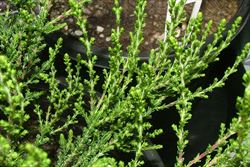
young growth (Photo: Sheldon Navie)

stems and leaves (Photo: Sheldon Navie)
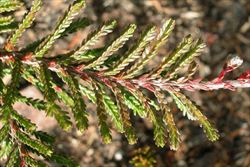
close-up of tiny scale-like leaves (Photo: Greg Jordan)
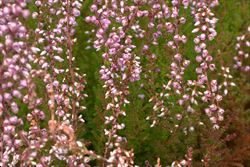
masses of flowers (Photo: Rob and Fiona Richardson)
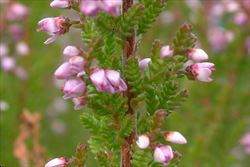
close-up of pink flowers and flower buds (Photo: Rob and Fiona Richardson)
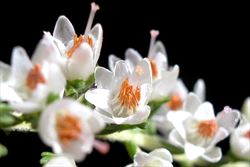
close-up of white flowers (Photo: Greg Jordan)
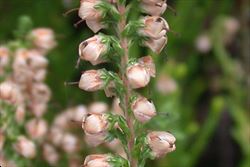
old flowers (Photo: Rob and Fiona Richardson)
Scientific Name
Calluna vulgaris (L.) Hull
Synonyms
Erica vulgaris L.
Family
Ericaceae
Common Names
heather, ling, red heath, Scotch heather, Scots heather
Origin
Native to Europe (i.e. Denmark, Ireland, Norway, Sweden, the United Kingdom, Belgium, Czechoslovakia, Germany, Hungary, the Netherlands, Poland, Switzerland, Belarus, Moldova, Russia, Ukraine, Albania, Bulgaria, Greece, Italy, Romania, Yugoslavia, France, Portugal and Spain), Morocco and Turkey.
Cultivation
Heather (Calluna vulgaris) has been deliberately planted in gardens and for erosion control, mainly in the cooler temperate parts of southern Australia.
Naturalised Distribution
Locally naturalised in Tasmania (i.e. it is sparingly naturalised at Kingston south of Hobart, and has also been recorded in central Tasmania, on Bruny Island and around Mt Wellington).
Also naturalised overseas in Finland, New Zealand, Canada, northern USA and Alaska.
Habitat
It grows in open woodlands, heathlands and grasslands and prefers acid soils and locations where the winters are relatively cold (i.e. alpine areas).
Habit
This long-lived (i.e. perennial) shrubby plant can vary in habit from a low-lying matlike (i.e. prostrate or decumbent) form to upright (i.e. erect or ascending) bushes or dwarf trees, depending on its environment. It usually reaches less than 50 cm in height, but can grow 0.5-1.25 m tall.
Distinguishing Features
- a small shrubby plant usually growing less than 50 cm tall.
- its tiny scale-like leaves are arranged in four vertical rows along the branches.
- its pink or pale purple, bell-shaped, flowers have four petals that are joined together at the base.
- its tiny round capsules are hairy and have four compartments.
Stems and Leaves
Its older woody stems are much-branched, flexible and hairless (i.e. glabrous). Younger stems are initially densely hairy (i.e. pubescent) and green in colour.
The small, stalkless (i.e. sessile) scale-like leaves are oppositely arranged in four vertical rows along the branches (i.e. they are decussate) and often overlap each other on the non-flowering shoots. These leaves are oblong, triangular or slightly elongated in shape (up to 3.5 mm long) and hairless or occasionally downy (i.e. glabrous or finely pubescent). They are initially dark green but turn brown as they age.
Flowers and Fruit
The small, bell-shaped (i.e. tubular), flowers are borne hanging downwards (i.e. they are pendent). Each flower has eight stamens, four tiny petals (about 2 mm long) that are partially joined into a short tube (i.e. corolla tube), and four larger petal-like sepals (2-4 mm long). The petals and sepals are generally pale purple, although they may occasionally be pink or white. Fowers are borne singly in the forks (i.e. axils) of the tiny leaves along short branches (up to 9 cm long) on the upper part of the plant. The flower buds start to develop during autumn and flowering occurs mainly during winter. As the fruit begin to ripen, the petals turn brown and dry out and the flower moves from hanging downwards (i.e. pendent) to an upright (i.e. erect) position.
The small, rounded (i.e. spherical), capsules (2-2.5 mm wide) are densely covered in hairs (i.e. they are pubescent) and remain hidden inside the petals (i.e. persistent corolla). They are made up of four compartments, each containing numerous tiny seeds (about 0.7 mm long and 0.5 mm wide) that have a network-patterned (i.e. reticulate) surface texture.
Reproduction and Dispersal
Heather (Calluna vulgaris) reproduces mainly by seed, which can remain viable for extended periods (i.e. up to 100 years). Vegetative reproduction can also take place via a process known as layering, where branches in contact with the soil take root and form new plants.
Seeds are spread by wind and vehicles, animals or walkers brushing against the plants.
Environmental Impact
Although not yet widespread in Australia, and currently restricted to some parts of Tasmania, heather (Calluna vulgaris) has the potential to adversely affect environmentally sensitive areas. Because of this, and that fact that it is a serious weed overseas, it is on the Alert List for Environmental Weeds.
Mature plants form a dense canopy in sensitive open upland habitats. Because it forms a persistent leaf litter layer, sites with vigorous heather (Calluna vulgaris) populations are often virtually devoid of other species. This ability to dominate and displace the native vegetation leads to a severe loss of biodiversity and a reduction in the habitat available to native animals. It can colonise altitudes up to 1500 m and is therefore seen as a serious threat to Australia’s alpine country. In Australia it could become an invasive weed in the alpine and sub-alpine areas of Tasmania, Victoria, southern New South Wales and the ACT.
It is of great concern in the high country of New Zealand, where it covers an estimated area of 6000 square km. In Mt Tongariro National Park it is the most widespread exotic weed species and competes with a wide range of native plants. It is also causing concern along the Atlantic coast of North America (i.e. from Quebec to New Jersey).
Other Impacts
Because it grows in alpine and sub-alpine grasslands, heather (Calluna vulgaris) also has the potential to reduce the productivity of highland pastures if it becomes widely naturalised in south-eastern Australia.
Legislation
This species is declared under legislation in the following states and territories:
- Tasmania: D - the importation or sale of this species is prohibited and measures to reduce its population in an area, eradicate it from an area, or restrict it to a particular area may be required. Details on actual restrictions or measures for each declared weed are contained in the weed management plan for that species.
- Western Australia: Unassessed - this species is declared in other states or territories and is prohibited until assessed via a weed risk assessment (throughout the entire state).
Similar Species
Heather (Calluna vulgaris) is similar to several closely-related introduced species including berry-flowered heath (Erica baccans), bell heath (Erica cinerea), Spanish heath (Erica lusitanica) and tree heath (Erica arborea). These species can be distinguished by the following differences:
- heather (Calluna vulgaris ) is a low-growing shrub (generally less than 0.5 m tall) with purple, pink or whitish flowers that are relatively small (2-4 mm long). Its short, oblong or triangular leaves (up to 3.5 mm long) are arranged in opposite pairs.
- berry-flowered heath (Erica baccans) is a larger shrub (up to 3 m tall) with magenta coloured flowers that are moderately sized (about 6 mm long). Its very elongated leaves are arranged in whorls of four.
- bell heath (Erica cinerea) is a low-growing shrub (generally less than 0.5 m tall) with pink or reddish flowers that are moderately large (about 6 mm long). Its elongated needle-like leaves are arranged in whorls of three or four.
- Spanish heath (Erica lusitanica) is a larger shrub (up to 2 m tall) with relatively small (3-5 mm long) white or pale pink flowers that turn brown as they age. Its elongated leaves (3-7 mm long and less than 1 mm wide) appear to be arranged in whorls of three or four.
- tree heath (Erica arborea) is a larger shrub (up to 5 m tall) with relatively small (2.5-4 mm long) white flowers that have darker red (i.e. maroon) coloured throats. Its elongated leaves (3-5 mm ) appear to be arranged in whorls of three or four.
It may also be confused with the native species known as common heath (Epacris impressa). However, common heath (Epacris impressa) has larger and more elongated leaves (4-13 mm long and 1-3 mm wide) that are clearly alternately arranged and do not appear to be whorled. Its flowers are also much larger (6-18 mm long).

